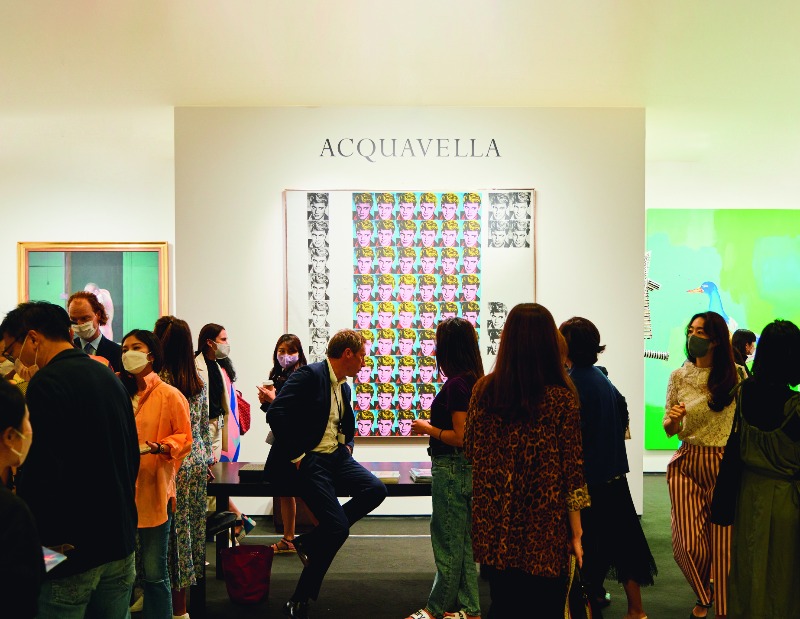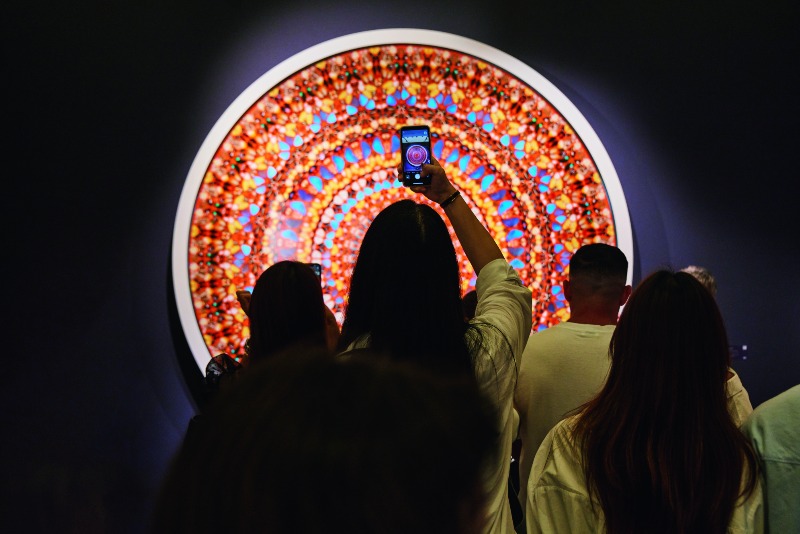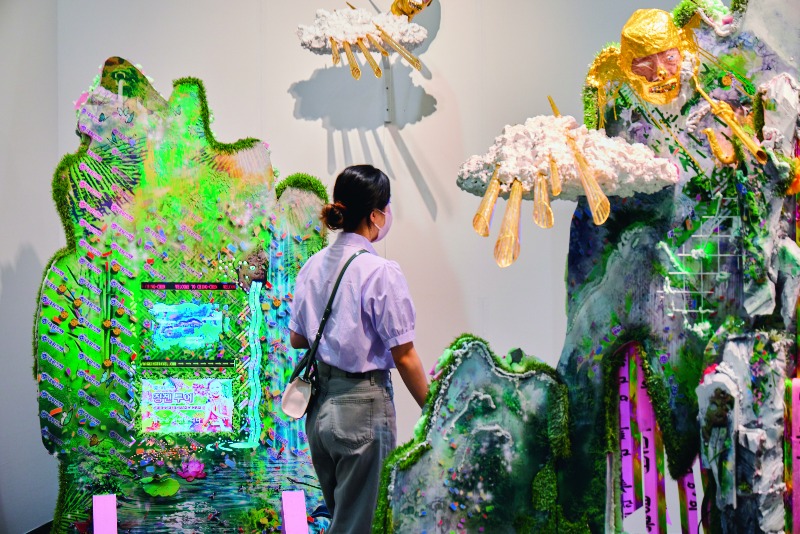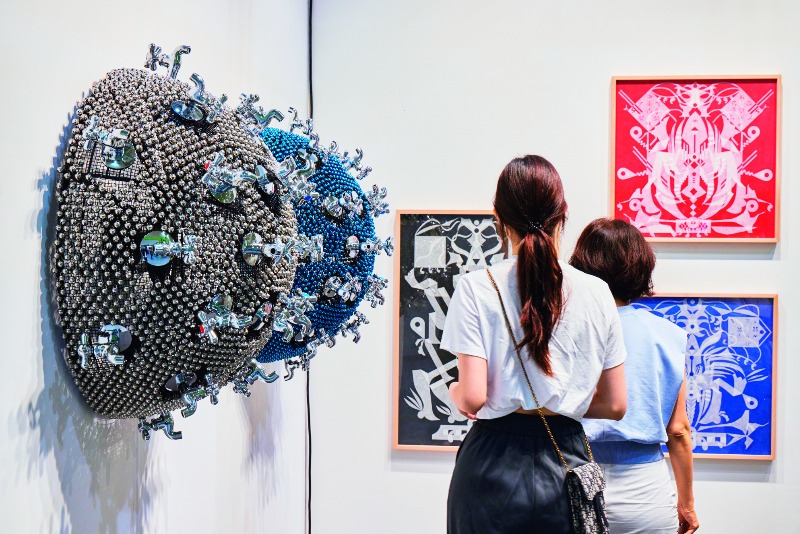Major galleries from around the world have set up shop in Korea in recent years, confirming the country’s rise in the global art world. The selection of Seoul to host the annual, world renowned Frieze Art Fair makes it an Asian hub of international elite museums and galleries.

The first Frieze Seoul international art fair, held in September 2022, drew international galleries and large crowds. Pictured is the booth of Acquavella Galleries, which exhibited masterpieces by Andy Warhol and Jean-Michel Basquiat.
© Frieze Seoul, Photo by Lets Studio
Frieze, one of the most prominent international art fairs, conjures up images of billionaire collectors, exclusive dealers, and curators from the top museums and galleries descending on London, New York, and Los Angeles to browse and spend small fortunes.
Enter Seoul. In September 2022, the immense potential of the Korean art community was underscored as Frieze introduced Seoul as its first location in Asia. The maiden fair did not disappoint. The Tate Modern and Serpentine galleries in London; the Museum of Modern Art and the Guggenheim Museum in New York; the Los Angeles County Museum of Art; and the Pinault Collection in Paris were among the prestigious institutions represented at the premiere in Seoul’s sprawling Coex exhibition venue.
The event also fueled the resurgence of the local art world, which has been driven by interest in interior design, as work-from-home has become more common, and a thirst for cultural indulgence coupled with “revenge spending.”

Visitors take pictures in front of Damien Hirst’s “High Windows (Happy Life)” (2006). Booths displaying famous works rarely seen in Korea became popular photo spots.
© Frieze Seoul, Photo by Lets Studio
Emotions overflowed on the opening day of Frieze Seoul, which was held alongside Kiaf Seoul, the longest-running local art fair of 20 years. “I cannot believe that, here in Seoul, I’m seeing the collectors I met at Art Basel in Switzerland. It’s truly amazing,” exclaimed Park Won-jae, CEO of ONE AND J. Gallery. He has attended numerous art fairs around the world but never imagined he would witness such an event in Korea. A total of 110 galleries from 21 countries were invited to Frieze Seoul, and 164 galleries from 17 countries to Kiaf Seoul. On the opening day, so many international attendees were present that more English could be heard than Korean — and the crowd did not just come to look.
Gagosian, Lisson Gallery, and Hauser & Wirth, top galleries showcasing their works in Korea for the first time, racked up tens of millions of dollars in sales in just the first hour. A gallerist with Hauser & Wirth’s New York branch commented that the buyers included private art collectors from Korea and China as well as private art museums in Japan. Art galleries that had already established outposts in Korea, as if they had foreseen this day, reported more stable sales. Perrotin, which participated in both Frieze and Kiaf, sold out on the first day.
Art fairs do not release sales figures, but a New York gallerist predicted that total sales of Frieze Seoul would reach around 650 billion won ($500 million), which seems a reasonable estimate.
However, selling works was not the only activity. Art fairs are also venues for sellers to connect with potential future customers, and that was evident at Frieze Seoul. Egon Schiele’s paintings and drawings and Pablo Picasso’s “Girl with a Red Beret and Pompom” (1937), difficult to see in Korea, drew long lines and became photo hotspots. Korean visitors in their 20s and 30s showed great interest in medieval manus, old maps, and Egyptian artifacts that they would normally only be able to see at foreign museums.
Why Seoul?

Exhibition booth of P21 Gallery with Ryu Sung-sil’s video installation “BigKing Travel Ching Chen Tour —Mr. Kim’s Revival” (2019). Korean galleries spotlighted contemporary masters and young, up-and-coming artists.
© Frieze Seoul, Photo by Lets Studio
Frieze is a latecomer to the exhibition scene. Launched in England in 2003, it created a sensation with a tent-style exhibition hall that showcased experimental artworks and is now one of the two most prominent international art fairs along with Art Basel, which began in 1970. Frieze expanded to New York in 2012 and Los Angeles in 2019.
The selection of Seoul for the Asian branch of Frieze was an easy choice for two reasons, according to Frieze CEO Simon Fox. “The first is the number of artists, galleries, museums, and collections in the city. The second is that Korean culture is having a huge impact across the world at the moment, whether that’s music, film, fashion, architecture, or art. I think that what happens here in Seoul is globally important,” he said.
Francis Belin, Asia-Pacific president of the auction house Christie’s, which hosted an exhibition timed with Frieze, highly rated Seoul’s growth potential as a cultural city, citing the Korean art world’s robust infrastructure and potential. After introducing an Agnes Martin painting to Hong Ra-hee, former director of Leeum Museum of Art, Pace Gallery President and CEO Marc Glimcher said, “The Korean market has strong growth potential fueled by a solid collector base that has seen an influx of young, affluent art enthusiasts whose influence has grown since the pandemic. We are actively seeking to introduce artists of diverse styles to cater to their tastes.”
The average art market size of OECD countries is around 0.2 percent of their gross national product. The Korean art market hovered around 0.02 percent until last year, when it reached 0.04 percent with total sales exceeding one trillion won ($765 million).
The potential to expand fivefold to reach the OECD average is a realistic possibility, and the internal dynamism is backed by rising interest in the Asian art market. Art Basel 2013 was staged in Hong Kong, in large part to attract the new young-and-rich generation in China and Southwest Asia. According to Artprice, a French online database, Asia accounted for 40 percent of the global art market in 2021.
A generational shift in the art industry is another factor. According to “The Art Market 2021,” a report published by Art Basel and UBS, millennials accounted for 52 percent of high-net-worth collectors worldwide, more than four times that of boomers, their parents’ generation. Also, millennials recorded the highest expenditure on art in 2020 with a median of $228,000, double that of boomers, who spent $109,000.
Other important factors are accessibility and infrastructure. Seoul is served by Incheon International Airport, a global aviation hub that is easily reached from anywhere in the world, and a wealth of hotels is within easy reach of Coex. During the art fair’s run, hotels in Gangnam, Samcheong-dong, and Hannam-dong, where galleries are concentrated, enjoyed brisk business. A foreign collector who attended Frieze Seoul vowed to come back, saying, “Just as much as seeing the artwork, it was a delight to run into Korean celebrities. I want to come back next year with my kids, who are K-pop fans.”
Task at Hand

Visitors admire the installation by Haegue Yang at the booth of Kukje Gallery, one of the 12 Korean galleries at Frieze Seoul.
© Frieze Seoul, Photo by Lets Studio
Local galleries that participated in Frieze Seoul showcased works mainly by modern and contemporary masters, as well as young up-and-coming artists. Hakgojae Gallery chose to spotlight 20th-century Korean abstract artists, such as Ryu Kyung-chai (1920– 1995) and Ha In-doo (1930–1989). A foreign gallerist who stopped by the booth marveled, “I never knew such Korean artists and works existed.”
The Korean art world hoped for a trickle-down effect by holding Kiaf alongside Frieze. Indeed, foreign media gave substantial coverage to Korean art, which is not common, and Frieze visitors also went to Kiaf. Thaddaeus Ropac, founder and owner of the Galerie Thaddaeus Ropac in Europe, which opened its first Asian branch in Seoul, closely inspected the booths at Kiaf on the opening day. The renowned Austrian gallerist made quite an impression as he walked around the venue at such a fast pace that his face was red from excitement. While Korean collectors flocked to Frieze, many foreign collectors visited the booths of Korean galleries at Kiaf or Korean artists’ studios.
“Frieze and Kiaf Seoul confirmed the elevated cultural status of Korea,” said Woo Chan-kyu, CEO of Hakgojae Gallery. “Culture is a cohesive unit; if one field, such as music, flourishes, it spurs the development of other fields, such as literature and art. I believe the era of K-art has arrived.”
Spring is the right time to prepare for fall. This year’s Frieze Seoul edition opens on September 6. In the run-up, rather than focusing on sales, the Korean art community must expand the foundation for growth. It should promote its uniqueness instead of trying to compete with the world’s top art galleries, and would do well to reflect on the global success of BTS, the K-drama “Squid Game,” and the film “Parasite.” The Korean art world has been handed the task of bolstering its capacity by discovering new local talent. It will need to present unique projects and works that inspire foreign art enthusiasts who visit the country as well as local audiences who have developed an appetite for cultural consumption.
Cho Sang-inReporter, Seoul Economic Daily